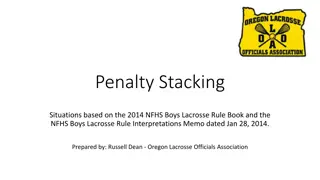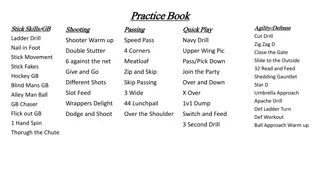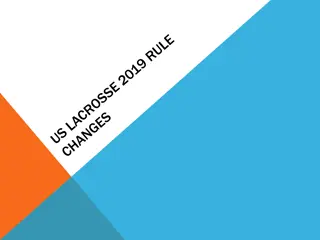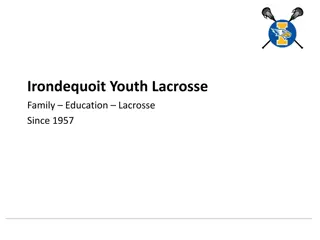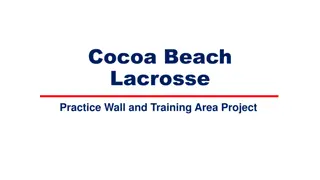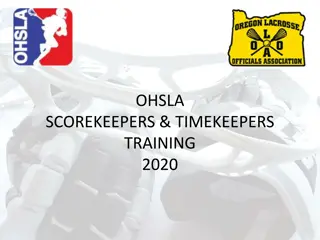History and Evolution of Lacrosse Equipment and Gameplay
Discover the rich history and evolution of lacrosse, from its origins in the 17th century to modern-day equipment advancements for speed and performance. Explore the development of sticks, heads, and gear, and learn about the game's global growth and impact. From traditional wooden sticks to titanium shafts and specialized positions, delve into the world of lacrosse and its enduring legacy as a fast-paced, dynamic sport.
Download Presentation

Please find below an Image/Link to download the presentation.
The content on the website is provided AS IS for your information and personal use only. It may not be sold, licensed, or shared on other websites without obtaining consent from the author. Download presentation by click this link. If you encounter any issues during the download, it is possible that the publisher has removed the file from their server.
E N D
Presentation Transcript
Branden Harbaugh HENDRIX COLLEGE THE FASTEST GAME ON TWO FEET LACROSSE
HISTORYTHE ONE TRUE AMERICAN SPORT.
HISTORY OF LACROSSE 1636 - Jesuit Missionary Jean de Brebeuf is the first to document the game of lacrosse 1794 - A match between the Seneca and Mohawks results in the creating of basic rules. 1834 - Caughnawaga Indians demonstrate the sport in Montreal. 1876 - Queen Victoria watched and "endorses" a lacrosse game in Windsor, England. New York University is the first college in the United States to establish a lacrosse team. 1881 - The first intercollegiate tournament is held at Westchester Polo Grounds in New York. 1890 - The first women's lacrosse game is played at St. Leonard's School in St. Andrew's, Scotland. 1904 - Lacrosse is first played as an actual event in the Olympics in St. Louis, with Canada winning the gold medal 2001 - Major League Lacrosse, a professional league for field lacrosse, makes its debut. 2010 - A record 29 nations participate in the FIL Men's World Championship.
EQUIPMENT Ball Stick attack/middie defensemen--goalies Gloves Helmet Elbow pads Shoulder pads
STICKS2013: ENGINEERED FOR SPEED AND DURABILITY Titanium shaft Die cast plastic heads Mesh pocket Channel built for high speed shooting Different sized heads/shafts for specialized positions
OFFENSE/DEFENSE STICKS Defense 72 inches Attack/middies 42 inches
BALLSOLID RUBBER, 5 OUNCES, 8 INCH CIRCUMFERENCE
BENEFITS Peak physical fitness most games are 60 minutes of sprinting, each practice and game averages 4-8 miles of sprinting. Hand/eye coordination and focus ball travels 40-80 mph on passes, 80-110 mph on shots. Teamwork offensive and defensive schemes, total team transition plus specialized units defensive midfield, long stick middies, face-off middies, man down, man up units, goalies, attack, middies and defensemen. Strength training and conditioning, change of direction agilities, flexibility.
POSITIONS ATTACKMEN three designated offensive players on one end of the field, pitted against the opposing team s defensemen and goalie. MIDFIELDERS play the entire field, and carry the ball way from the defense and toward the attack. Also play defense, take face-offs. Play offense and also score DEFENSEMEN carry longer poles for the purpose of playing against the opponent s attackmen, and dislodging the ball from them. GOALIE stands in a 6 x 6 goal, protecting it from a 5oz, 8 inch ball.
ATTACKMEN Great change of direction Physical toughness Intelligent players Highly skilled players on the field Passing catching shooting dodging Go against defensemen who have longer poles (6 feet) and are traditionally larger quarterbacks
MIDDIES Workhorses Fast and north south dodgers Able to shoot on the run Must play physical defense and run the whole game in a sprint. FACE-OFFS Toughness Running backs/defensive backs/safeties
DEFENSE Best all around athletes, very fast also Bigger than others, generally speaking Very physical and aggressive Great change of direction and also all directional speed Linebackers, defensive ends
GOALIES All shapes and sizes, large, athletic. Hand eye coordination shots are 80-110 MPH (11% faster than a baseball pitch) and taken at 2-12 yards (60% closer than a pitcher to batter) Once they have the ball they become the quarterback Without the ball they conduct the defense Good save percentage at NCAA level is 60%
SIMPLIFIED RULES Face-offs on the ground for possession after each goal, and at the beginning of each quarter. 15 minute quarters (2 timeouts each half) Sudden death overtime No ties 10 student athletes on the field at all times from each team (3 attack, 3 defensemen, 3 middies, and 1 goalie) Only six offensive players and seven defensive players (goalie) over the midline at once.
RULES CONTINUED AND CONCEPTS 6 on 6 same concepts as basketball. IE pick and roll, pick and slip, drive to the cage and move the ball twice. Inside shots outside shots. Defensively similar to basketball man defense, zone defense, lock off certain players, like adjacent, top player, etc. Clearing the ball similar to basketball, RIDING is the concept of a basketball press. Penalties for cross checking, helmet to helmet hits, slashing, pushing with possession, tripping, going offsides. https://www.youtube.com/watch?v=fwrVye6QSiA
SITUATIONS MAN UP/MAN DOWN (power play in hockey) Penalized team may have one or more players sit out for a fixed period of time. This gives the offensive team a 6 on 5 or less advantage Ground balls Face-offs Clears/rides
FACE-OFF https://www.youtube.com/watch?v=PLnvXXp5CJo
BOX/INDOOR LACROSSE https://www.youtube.com/watch?v=1KDTQ9Z-jVQ
BOX LACROSSE Larger goalie pads Much smaller net Traditionally played in colder areas Canada, Czech Republic, northern areas. Requires tremendous skill in shooting, pinpoint feeding in assists, and very physical All sticks are SHORT STICKS Canadian players tend to stick with their strong hand and are not as ambidextrous or confident with both as Americans
NCAA GRADUATION RATES Men's Sports Sport Lacrosse88% Gymnastics Fencing 88% Water Polo85% Ice Hockey84% Swimming Tennis Golf Volleyball Rifle Soccer CC/Track Skiing Wrestling Football 66% Baseball 66% Basketball Average 77.6% Women's Sports Sport 95% NCAA GSR Federal Rate 75% 88%72% 70% 69% 68% 82% 82% 63% 79% 60% 78% 78% 62% 77% 58% 74% 73% 60% 70% 55% 45% 61% NCAA GSR Federal Rate 79% 85% 83% 94% 82% 83% Swimming 91% Ice Hockey 90% 74% Crew/Rowing 90% 65% Soccer 89% Volleyball 88% 71% Tennis 88% 70% 60% Golf 87% Water Polo 85% 77% 53% Softball 85% CC/Track 83% 68% Basketball 81% 64% 45% Rifle 77% Bowling 68% 59% 87.3% 73.4% Skiing Gymnastics94% Lacrosse94% Field Hockey Fencing 68% 93% 75% 73% 71% 69% 70% 68% 61.6%
GROWTH IN HS BOYS SPONSORSHIP AND PARTICIPATION 2006 2007 2008 2009 2010 2011 2012 01-12 1,395 1,588 1,815 1,984 2,068 2,192 2,338 149.3% SCHOOLS # s in 1,000 s 2006 2007 2008 2009 2010 2011 2012 01-12 65.0 71.5 82.9 88.5 90.7 95.7 100.6 140.6%
HIGHLIGHT REEL https://www.youtube.com/watch?v=IkRuWFY5M1U
GETTING INVOLVED www.uslacrosse.org www.littlerocklacrosse.com www.hendrixwarriors.edu www.Laxpower.com Boys and girls ages 6-18, mens leagues and women s leagues, high school, NCAA professional indoor and outdoor, amateur international and national teams.








